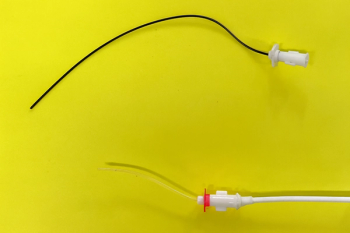
Protein-losing nephropathies (Proceedings)
Many forms of glomerular disease are thought to be associated with the presence of immune complexes in glomerular capillary walls.
Many forms of glomerular disease are thought to be associated with the presence of immune complexes in glomerular capillary walls. Familial glomerulopathy also result in proteinuria due to structural abnormalities in glomerular capillary wall collagen. In addition, glomerular amyloidosis can result in proteinuria. Immune complex glomerulonephritis (GN) is more common than familial or amyloid glomerulopathy and therefore this review will focus on the treatment of GN. In addition to the long-standing treatment recommendations of decreasing antigenic stimulation and immunosuppression, newer treatments with angiotensin-converting enzyme inhibitors (ACEI) that decrease proteinuria and intraglomerular hypertension are showing promise.
Pathophysiology
Circulating antigen-antibody complexes may be deposited or trapped in the glomerulus or immune complexes may form in situ in the glomerular capillary wall. In situ immune complex formation occurs when circulating antibody reacts with "planted", non-glomerular antigens in the glomerular capillary wall. These antigens may localize in the glomerular capillary wall due to electrical charge interaction or biochemical affinity with the glomerular capillary wall. For example, evidence suggests in situ immune complex formation occurs in dogs with glomerulonephritis associated with heartworm disease.
After formation or deposition of immune complexes in the glomerular capillary wall, several factors including production of cytokines, eicosanoids, and growth factors, activation of complement, platelet aggregation, infiltration of polymorphonuclear leukocytes, activation of the coagulation system, and fibrin deposition contribute to glomerular damage. Platelet activation and aggregation occur secondary to vascular endothelial damage or antigen-antibody interaction. Platelets, in turn, exacerbate glomerular damage by release of vasoactive and inflammatory substances (e.g., thromboxanes) and by facilitation of the coagulation cascade. The glomerulus responds to this injury by cellular proliferation, thickening of the glomerular basement membrane, and eventually, hyalinization and sclerosis. The primary pathophysiologic response to this injury is proteinuria.
Clinical Signs
The clinical signs associated with mild to moderate urinary protein loss may be absent or, if present, mild and nonspecific such as weight loss and lethargy. If protein loss is severe, however, edema and or ascites will often occur. Extensive glomerular disease may render greater than 3/4 of the nephrons nonfunctional resulting in renal failure (azotemia, polydipsia-polyuria, anorexia, nausea, and vomiting). Occasionally, signs associated with an underlying infectious, inflammatory, or neoplastic disease may be the reason owners seek veterinary care. Rarely, dogs may be presented with acute dyspnea or severe panting due to pulmonary thromboembolism.
Persistent proteinuria can lead to clinical signs of the nephrotic syndrome. The combination of significant proteinuria, hypoalbuminemia, ascites or edema, and hypercholesterolemia is defined as the nephrotic syndrome. In addition to these clinical signs, hypertension and hypercoagulability are frequent complications in dogs with nephrotic syndrome. Hypertension probably occurs due to a combination of sodium retention, glomerular capillary and arteriolar scarring, decreased renal production of vasodilators, increased responsiveness to normal pressor mechanisms, and activation of the renin-angiotensin system. Retinal changes, including hemorrhage, detachment, and papilledema, may be the first indication of hypertension and an acute onset of blindness may be the presenting complaint in hypertensive dogs. Blood pressure measurement can help in the evaluation and management of patients with glomerular disease; identification and control of systemic hypertension may attenuate the progression of the glomerular disease. Systemic hypertension that is transmitted into glomerular capillaries may augment proteinuria and contribute to loss of nephrons due to glomerulosclerosis.
Hypercoagulability and thromboembolism associated with the nephrotic syndrome occur secondary to several abnormalities in the clotting system. In addition to a mild thrombocytosis, a hypoalbuminemia-related platelet hypersensitivity increases platelet adhesion and aggregation inversely proportional to the magnitude of hypoalbuminemia. Loss of antithrombin III in urine also contributes to hypercoagulability. Antithrombin III works with heparin to inhibit clotting factors and normally plays a role in modulating thrombin and fibrin production. Finally, altered fibrinolysis and increases in the concentration of large molecular weight clotting factors lead to a relative increase in clotting factors vs regulatory proteins. The pulmonary arterial system is the most common location for a thromboembolism to lodge. Dogs with pulmonary thromboembolism usually have dyspnea and are hypoxic with minimal pulmonary parenchymal radiographic abnormalities. Treatment of pulmonary thromboembolism is difficult, often expensive, and frequently unrewarding and therefore, early prophylactic treatment is important.
Quantitation of Proteinuria:
Calculation of the urine protein/creatinine ratio from canine urine samples has been shown to accurately reflect the quantity of protein excreted in the urine over a 24-hour period. This test has greatly facilitated the diagnosis of glomerulonephritis in veterinary medicine. In addition, the magnitude of proteinuria has been shown to roughly correlate with the severity of glomerular lesions making the urine protein/creatinine ratio a useful parameter to assess response to therapy or progression of disease.
Most studies suggest that normal urine protein excretion in dogs is less than 10 mg/kg/24-hrs, which roughly correlates with a urine protein/creatinine ratio of less than 0.5. Complete urinalyses are important since hematuria or pyuria may indicate significant non-glomerular proteinuria rendering the urine protein/creatinine ratio inaccurate.
The magnitude of proteinuria does appear to roughly correlate with the nature of the glomerular lesion. In several studies, although there was overlap, urine protein excretion in dogs with glomerulonephritis was greater than in dogs with glomerular atrophy or interstitial nephritis but less than dogs with amyloidosis. Urine and serum protein electrophoresis may help identify the source of the proteinuria and establish a prognosis. Proteinuria associated with hemorrhage into the urinary tract will have an electrophoresis pattern very similar to that of the serum. Early glomerular damage usually results principally in albuminuria, however with progression of the glomerular disease; an increasing amount of globulin may be lost as well. Marked decreases in serum albumin and increased concentrations of larger molecular weight proteins in the serum are suggestive of severe glomerular proteinuria and the nephrotic syndrome.
Treatment:
Generation of immune complexes is dependent on the presence of antigen. The most important treatment for glomerular disease is identification and correction of any underlying disease processes. However, since an antigen source or underlying disease process is often not identified or is impossible to eliminate (e.g. neoplasia), immunosuppressive drugs are often recommended in the treatment of glomerulonephritis. Corticosteroids, azathioprine, cyclophosphamide, and cyclosporin have been used clinically or experimentally to prevent immunoglobulin production by B cells or to alter the function of T helper or T suppressor cells. Unfortunately, there are no controlled clinical trials that demonstrate the efficacy of immunosuppressive drugs in the treatment of canine or feline glomerulonephritis. The recent association between hyperadrenocorticism (and long-term exogenous corticosteroid therapy) and glomerulonephritis and thromboembolism in the dog, as well as the lack of consistent therapeutic response to treatment of glomerular disease with corticosteroids indicates that corticosteroids should be used with caution in dogs with glomerulonephritis. If immunosuppressive drugs are employed, proteinuria should be quantitated frequently to assess the effects of treatment. In some instances, immunosuppressive treatment may exacerbate glomerular lesions and proteinuria.
There is increasing evidence that platelets and their arachidonic acid metabolites (thromboxanes) are integrally involved in the pathogenesis of glomerulonephritis. Beneficial responses to anti-platelet therapy including aspirin, indomethacin, dipyridamole, thromboxane synthetase inhibitors, and platelet-activating factor antagonists have been demonstrated in several studies. Dosage appears to be important when nonspecific cyclooxygenase inhibitors such as aspirin are employed. Theoretically, low dose aspirin therapy (0.5 - 5 mg/kg PO BID) can selectively inhibit platelet cyclooxygenase without preventing beneficial prostacyclin (vasodilator and platelet aggregation antagonist) formation.
It was recently demonstrated that treatment with angiotensin-converting enzyme inhibition (ACEI) (enalapril) improves renal function and prolongs survival in male Samoyed dogs with hereditary nephritis. This primary glomerular disease results in chronic renal failure in affected dogs prior to one year of age. In addition, in dogs with unilateral nephrectomies and experimentally induced diabetes mellitus, ACEI administration (lisinopril) reduced glomerular transcapillary hydraulic pressure and glomerular cell hypertrophy as well as proteinuria. In another study in dogs with naturally occurring glomerulonephritis, treatment with enalapril reduced proteinuria and systolic blood pressure and prevented an increase in serum creatinine concentrations when compared to placebo-treated dogs. Treatment with ACEI probably decreases proteinuria and preserves renal function associated with glomerular disease by several mechanisms in addition to decreasing intraglomerular hypertension and cellular proliferation. Enalapril may prevent the loss of glomerular heparan sulfate that can occur with glomerular disease. Heparan sulfate is a glycosaminoglycan-proteoglycan that contributes to the negative charge of the glomerular capillary wall, which in turn hinders the filtration of negatively charged proteins such as albumin. Administration of ACEI is also thought to attenuate proteinuria by decreasing the size of glomerular capillary endothelial cell pores. Attenuation of proteinuria alone may be renoprotective inasmuch as a correlation between proteinuria and renal functional decline has been observed in several species.
Supportive therapy is important in the management of glomerulonephritis and should be aimed at decreasing hypertension, edema, and the tendency for thromboembolism to occur. Sodium reduced diets (< 0.3% dry matter) are often recommended but of no proven value. Angiotensin-converting enzyme inhibitors can reduce sodium retention and systemic hypertension in some nephrotic patients. Measurement of antithrombin III and fibrinogen concentrations may be helpful in determining which patients should be treated with anticoagulant therapy. Dogs with antithrombin III concentrations less than 70% of normal and fibrinogen concentrations greater than 300 mg/dl are candidates for therapy. Aspirin and coumadins have been employed for anticoagulant therapy, however low dose aspirin is easily administered on an outpatient basis and does not require extensive monitoring, as does coumadin treatment. Since fibrin accumulation within the glomerulus is a frequent consequence of glomerulonephritis, anticoagulant treatment may serve a dual purpose. Finally, protein reduced diets with n-3 fatty acid supplementation should be recommended in an attempt to decrease glomerular hyperfiltration and the non-immunologic progression of glomerular disease.
Newsletter
From exam room tips to practice management insights, get trusted veterinary news delivered straight to your inbox—subscribe to dvm360.



